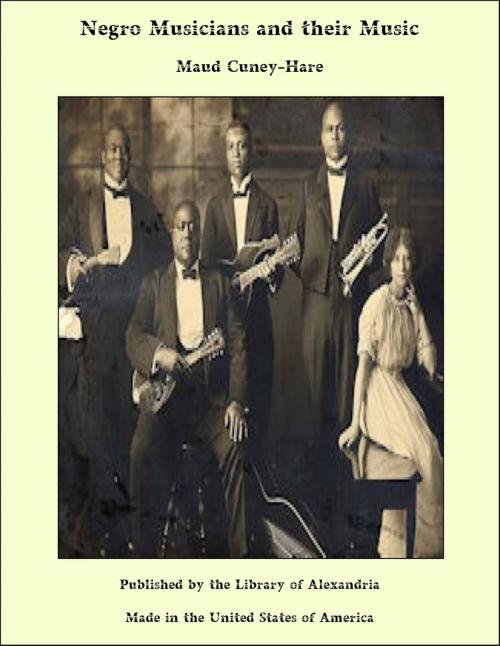Negro Musicians and their Music
Nonfiction, Religion & Spirituality, New Age, History, Fiction & Literature| Author: | Maud Cuney-Hare | ISBN: | 9781465604781 |
| Publisher: | Library of Alexandria | Publication: | March 8, 2015 |
| Imprint: | Language: | English |
| Author: | Maud Cuney-Hare |
| ISBN: | 9781465604781 |
| Publisher: | Library of Alexandria |
| Publication: | March 8, 2015 |
| Imprint: | |
| Language: | English |
In offering this study of Negro music, I do so with the admission that there is no consistent development as found in national schools of music. The Negro, a musical force, through his own distinct racial characteristics has made an artistic contribution which is racial but not yet national. Rather has the influence of musical stylistic traits termed Negro, spread over many nations wherever the colonies of the New World have become homes of Negro people. These expressions in melody and rhythm have been a compelling force in American music tragic and joyful in emotion, pathetic and ludicrous in melody, primitive and barbaric in rhythm. The welding of these expressions has brought about a harmonic effect which is now influencing thoughtful musicians throughout the world. At present there is evidenced a new movement far from academic, which plays an important technical part in the music of this and other lands. The question as to whether there exists a pure Negro art in America is warmly debated. Many Negroes as well as Anglo-Americans admit that the so-called American Negro is no longer an African Negro. Apart from the fusion of blood he has for centuries been moved by the same stimuli which have affected all citizens of the United States. They argue rightly that he is a product of a vital American civilization with all its daring, its progress, its ruthlessness, and unlovely speed. As an integral part of the nation, the Negro is influenced by like social environment and governed by the same political institutions; thus page vi we may expect the ultimate result of his musical endeavors to be an art-music which embodies national characteristics exercised upon by his soul's expression. In the field of composition, the early sporadic efforts by people of African descent, while not without historic importance, have been succeeded by contributions from a rising group of talented composers of color who are beginning to find a listening public. The tendency of this music is toward the development of an American symphonic, operatic and ballet school led for the moment by a few lone Negro musicians of vision and high ideals. The story of those working toward this end is herein treated. Facts for this volume have been obtained from educated African scholars with whom the author sought acquaintanceship and from printed sources found in the Boston Public Library, the New York Public Library and the Music Division of the Library of Congress. The author has also had access to rare collections and private libraries which include her own. Folk material has been gathered in personal travel.
In offering this study of Negro music, I do so with the admission that there is no consistent development as found in national schools of music. The Negro, a musical force, through his own distinct racial characteristics has made an artistic contribution which is racial but not yet national. Rather has the influence of musical stylistic traits termed Negro, spread over many nations wherever the colonies of the New World have become homes of Negro people. These expressions in melody and rhythm have been a compelling force in American music tragic and joyful in emotion, pathetic and ludicrous in melody, primitive and barbaric in rhythm. The welding of these expressions has brought about a harmonic effect which is now influencing thoughtful musicians throughout the world. At present there is evidenced a new movement far from academic, which plays an important technical part in the music of this and other lands. The question as to whether there exists a pure Negro art in America is warmly debated. Many Negroes as well as Anglo-Americans admit that the so-called American Negro is no longer an African Negro. Apart from the fusion of blood he has for centuries been moved by the same stimuli which have affected all citizens of the United States. They argue rightly that he is a product of a vital American civilization with all its daring, its progress, its ruthlessness, and unlovely speed. As an integral part of the nation, the Negro is influenced by like social environment and governed by the same political institutions; thus page vi we may expect the ultimate result of his musical endeavors to be an art-music which embodies national characteristics exercised upon by his soul's expression. In the field of composition, the early sporadic efforts by people of African descent, while not without historic importance, have been succeeded by contributions from a rising group of talented composers of color who are beginning to find a listening public. The tendency of this music is toward the development of an American symphonic, operatic and ballet school led for the moment by a few lone Negro musicians of vision and high ideals. The story of those working toward this end is herein treated. Facts for this volume have been obtained from educated African scholars with whom the author sought acquaintanceship and from printed sources found in the Boston Public Library, the New York Public Library and the Music Division of the Library of Congress. The author has also had access to rare collections and private libraries which include her own. Folk material has been gathered in personal travel.















